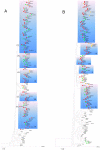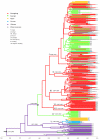HCV 6a prevalence in Guangdong province had the origin from Vietnam and recent dissemination to other regions of China: phylogeographic analyses
- PMID: 22253686
- PMCID: PMC3253785
- DOI: 10.1371/journal.pone.0028006
HCV 6a prevalence in Guangdong province had the origin from Vietnam and recent dissemination to other regions of China: phylogeographic analyses
Abstract
Background: Recently in China, HCV 6a infection has shown a fast increase among patients and blood donors, possibly due to IDU linked transmission.
Methodology/findings: We recruited 210 drug users in Shanwei city, Guangdong province. Among them, HCV RNA was detected in 150 (71.4%), both E1 and NS5B genes were sequenced in 136, and 6a genotyped in 70. Of the 6a sequences, most were grouped into three clusters while 23% represent emerging strains. For coalescent analysis, additional 6a sequences were determined among 21 blood donors from Vietnam, 22 donors from 12 provinces of China, and 36 IDUs from Liuzhou City in Guangxi Province. Phylogeographic analyses indicated that Vietnam could be the origin of 6a in China. The Guangxi Province, which borders Vietnam, could be the first region to accept 6a for circulation. Migration from Yunnan, which also borders Vietnam, might be equally important, but it was only detected among IDUs in limited regions. From Guangxi, 6a could have further spread to Guangdong, Yunnan, Hainan, and Hubei provinces. However, evidence showed that only in Guangdong has 6a become a local epidemic, making Guangdong the second source region to disseminate 6a to the other 12 provinces. With a rate of 2.737×10⁻³ (95% CI: 1.792×10⁻³ to 3.745×10⁻³), a Bayesian Skyline Plot was portrayed. It revealed an exponential 6a growth during 1994-1998, while before and after 1994-1998 slow 6a growths were maintained. Concurrently, 1994-1998 corresponded to a period when contaminated blood transfusion was common, which caused many people being infected with HIV and HCV, until the Chinese government outlawed the use of paid blood donations in 1998.
Conclusions/significance: With an origin from Vietnam, 6a has become a local epidemic in Guangdong Province, where an increasing prevalence has subsequently led to 6a spread to many other regions of China.
Conflict of interest statement
Figures




References
-
- Bao YP, Liu ZM. Current situation and trends of drug abuse and HIV/AIDS in China. HIV Ther. 2009;3:237–240.
-
- Garten RJ, Lai S, Zhang J, Liu W, Chen J, et al. Rapid transmission of hepatitis C virus among young injection heroin users in Southern China. Int J Epidemiol. 2004;33:182. - PubMed
-
- Bao Y, Liu Z, Lu L. Review of HIV and HCV infection among drug users in China. Curr Opin Psychiatry. 2010;23:187–194. - PubMed
Publication types
MeSH terms
Substances
Associated data
- Actions
- Actions
- Actions
- Actions
- Actions
- Actions
- Actions
- Actions
- Actions
- Actions
- Actions
- Actions
- Actions
- Actions
- Actions
- Actions
- Actions
- Actions
- Actions
- Actions
- Actions
- Actions
- Actions
- Actions
- Actions
- Actions
- Actions
- Actions
- Actions
- Actions
- Actions
- Actions
- Actions
- Actions
- Actions
- Actions
- Actions
- Actions
- Actions
- Actions
- Actions
- Actions
- Actions
- Actions
- Actions
- Actions
- Actions
- Actions
- Actions
- Actions
- Actions
- Actions
- Actions
- Actions
- Actions
- Actions
- Actions
- Actions
- Actions
- Actions
- Actions
- Actions
- Actions
- Actions
- Actions
- Actions
- Actions
- Actions
- Actions
- Actions
- Actions
- Actions
- Actions
- Actions
- Actions
- Actions
- Actions
- Actions
- Actions
- Actions
- Actions
- Actions
- Actions
- Actions
- Actions
- Actions
- Actions
- Actions
- Actions
- Actions
- Actions
- Actions
- Actions
- Actions
- Actions
- Actions
- Actions
- Actions
- Actions
- Actions
- Actions
- Actions
- Actions
- Actions
- Actions
- Actions
- Actions
- Actions
- Actions
- Actions
- Actions
- Actions
- Actions
- Actions
- Actions
- Actions
- Actions
- Actions
- Actions
- Actions
- Actions
- Actions
- Actions
- Actions
- Actions
- Actions
- Actions
- Actions
- Actions
- Actions
- Actions
- Actions
- Actions
- Actions
- Actions
- Actions
- Actions
- Actions
- Actions
- Actions
- Actions
- Actions
- Actions
- Actions
- Actions
- Actions
- Actions
- Actions
- Actions
- Actions
- Actions
- Actions
- Actions
- Actions
- Actions
- Actions
- Actions
- Actions
- Actions
- Actions
- Actions
- Actions
- Actions
- Actions
- Actions
- Actions
- Actions
- Actions
- Actions
- Actions
- Actions
- Actions
- Actions
- Actions
- Actions
- Actions
- Actions
- Actions
- Actions
- Actions
- Actions
- Actions
- Actions
- Actions
- Actions
- Actions
- Actions
- Actions
- Actions
- Actions
- Actions
- Actions
- Actions
- Actions
- Actions
- Actions
- Actions
- Actions
- Actions
- Actions
- Actions
- Actions
- Actions
- Actions
- Actions
- Actions
- Actions
- Actions
- Actions
- Actions
- Actions
- Actions
- Actions
- Actions
- Actions
- Actions
- Actions
- Actions
- Actions
- Actions
- Actions
- Actions
- Actions
- Actions
- Actions
- Actions
- Actions
- Actions
- Actions
- Actions
- Actions
- Actions
- Actions
- Actions
- Actions
- Actions
- Actions
- Actions
- Actions
- Actions
- Actions
- Actions
- Actions
- Actions
- Actions
- Actions
- Actions
- Actions
- Actions
- Actions
- Actions
- Actions
- Actions
- Actions
- Actions
- Actions
- Actions
- Actions
- Actions
- Actions
- Actions
- Actions
- Actions
- Actions
- Actions
- Actions
- Actions
- Actions
- Actions
- Actions
- Actions
- Actions
- Actions
- Actions
- Actions
- Actions
- Actions
- Actions
- Actions
- Actions
- Actions
- Actions
- Actions
- Actions
- Actions
- Actions
- Actions
- Actions
- Actions
- Actions
- Actions
- Actions
- Actions
- Actions
- Actions
- Actions
- Actions
- Actions
- Actions
- Actions
- Actions
- Actions
- Actions
- Actions
- Actions
- Actions
- Actions
- Actions
- Actions
- Actions
- Actions
- Actions
- Actions
- Actions
- Actions
- Actions
- Actions
- Actions
- Actions
- Actions
- Actions
- Actions
- Actions
- Actions
- Actions
- Actions
- Actions
- Actions
- Actions
- Actions
- Actions
- Actions
- Actions
- Actions
- Actions
- Actions
- Actions
- Actions
- Actions
- Actions
- Actions
- Actions
- Actions
- Actions
- Actions
- Actions
- Actions
- Actions
- Actions
- Actions
- Actions
- Actions
- Actions
- Actions
- Actions
- Actions
- Actions
- Actions
- Actions
- Actions
- Actions
- Actions
- Actions
- Actions
- Actions
Grants and funding
LinkOut - more resources
Full Text Sources
Medical
Molecular Biology Databases

